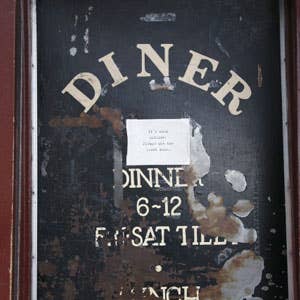
Restaurants succeed for all sorts of reasons. Some are funded by investors with deep pockets. Others have the backing of a luxury hotel group. Still others come with a brand-name chef attached to them. Such restaurants usually have a well-tailored culinary theme. They have a public-relations strategy. They have a business plan.
Then there are the places that grow and thrive because, well, it's in the stars. They're in the right place at the right time. They're tenacious. They labor under the steadfast belief that every customer and every dish counts. And they draw their energy not from publicity but from the community around them. Marlow & Sons, an eclectic eatery and food shop in the Williamsburg section of Brooklyn, decidedly falls into the latter category.
With its green-and-white pinstriped awning advertising "Groceries, Spirits, Oysters" and its unfancy façade, Marlow & Sons seems almost fusty on the outside, but it has the soul of a garage band. It plays to a local and loyal fan base, and its riffs are simple but true. The regulars are mostly the artists, musicians, graphic designers, and students who have transformed this once hard-bitten waterfront neighborhood into a bustling and vibrant hipster factory. The establishment stands next door to its sister restaurant and popular forerunner, Diner, which occupies an old Kullman dining car.
The front of Marlow & Sons consists of an assemblage of display cases and shelves stocked with fresh baked goods, artisanal soda pop and potato chips, and culinary curios. Baguettes poke out from a chipped enameled-metal bin labeled bread. A chalkboard advertising the day's specials hangs next to a pegboard holding antique knives. Separated from the shop by a wood-paneled doorway, the dining room is a sort of cross between a cabin in Alaska and a Parisian bistro. Wall sconces cast a soft yellow light over wood benches and mismatched tables and chairs, and oysters on the half shell glisten on ice behind a bar at one end of the room.
Many of the customers huddle over plates of house-made charcuterie and pate, cheese, and olives, but every time I visit, which is often, I direct my attention to the specials board. The last time I was there, it listed a flat iron steak with herb butter; crostini of black-eyed pea puree, marinated radicchio, and golden raisins; black bass over clams, chickpeas, escarole, and chorizo; and a chocolate caramel tart sprinkled with sea salt. It is honestly curated homemade fare, and always delicious.
If the place could be said to have a signature dish, it's the brick chicken—a whole, partially deboned bird pressed into a hot skillet and squished down with a 35-pound piece of scrap metal salvaged from the Brooklyn Navy Yard. Crisp and buttery and nestled in pool of a lemon-spiked pan sauce, it is the portrait of simplicity. "I was inspired by something Mario Batali once said about every menu's needing to have something for everyone," says the Marlow & Sons chef, Sean Rembold, a sturdy-looking 32-year-old with thick-framed glasses. After the chicken's debut, Andrew Tarlow, one of the restaurant's owners, told Rembold, "Never, never take that off the menu."
Marlow is a contraction of Tarlow's name and that of the other owner, Mark Firth. The two had worked together at the Odeon, a pioneering Manhattan bistro, before opening Diner on a shoestring in 1998, on the cusp of Williamsburg's wildfire gentrification. There, they created a place with an out-of-the-way, speakeasy feel. Its arrestingly short menu was received by many first-time visitors as ironic. "We had a business based on a salad, a burger, and a couple of steaks," says Tarlow. "It was built on necessity, really, as we couldn't afford a big menu." I started going to Diner in 1999 and quickly became a regular. I remember Firth's letting out a cheer when I arrived dressed to the nines for an Oscars night. I remember the day in 2000 when I had my first hamburger in more than ten years, putting the final nail into the coffin of my vegetarianism. I remember the night I took my parents there, and, after an unhurried meal and plenty of wine, they told me the story of how they met and fell in love. The place became part of the weave of city life for me, just as it became part of the fabric of the neighborhood.
Marlow & Sons grew from those neighborhood roots. Firth and Tarlow conceived the place merely as a sort of general store where they could sell some of the high-quality ingredients they used at Diner. But they were restaurant people, not shopkeepers, so they added tables in the back and started serving oysters, charcuterie, cheeses, and simple dishes that didn't compete with those of Diner. Their customers, many of them spillovers from Diner, fell in love with the restaurant and its food and started asking when the management was going to expand the menu. So, Firth and Tarlow have just been going along with it.
Having two full-fledged restaurants side by side that share ingredients and staff is a bit like managing a sibling rivalry. Jason Schwartz, a manager at Marlow & Sons, tried to put it in terms he thought I'd understand. "Diner is beers and shots," he said. "Marlow is more like a glass of sherry." Then: "No, wait. Diner is like Led Zeppelin, and Marlow is like Robert Plant's solo career. Or something like that." While that dynamic plays out, Firth and Tarlow have opened a butcher shop, specializing in local meat, up the street called Marlow & Daughters, another child in their brood and, most likely, another boon for this corner of Brooklyn. "We enjoy being here," Tarlow told me. "We love feeling appreciated in the neighborhood."
Keep Reading
Continue to Next Story










